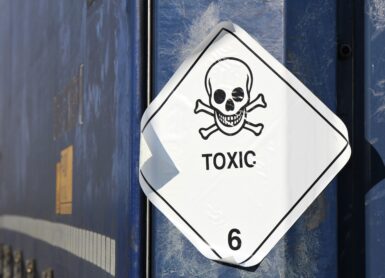
According to the American Institute of Chemical Engineers (AIChE), a Vapour Cloud Explosion (VCE) is the explosion resulting from the ignition of a cloud of flammable vapour, gas, or mist in which flame speeds accelerate to sufficiently high velocities to produce significant overpressure.
VCEs are generally seen as one of the most destructive accident scenarios in petrochemical operations. That is the reason why predicting potential consequences of VCEs is of extreme importance in safety assessments because this allows us to take mitigating measures adapted to the expected consequences.
For an accurate and very detailed prediction of blast effects of VCEs, one can perform a Computational Fluid Dynamic (CFD) simulation, which requires a detailed 3D description of the environment, including all obstructing geometries. Not only the geometry of surrounding buildings needs to be described, but also vegetation (such as trees) which often must be estimated since they are not documented. However, this methodology is very time-consuming, laborious, and requires a high level of CFD expertise. Additionally, CFD results are sensitive to the chosen geometries. That is why it may be impractical to use for a total site analysis.
The Multi-Energy model
As an alternative to CFD, the Multi-Energy model can be applied, which is an easy, straightforward, and not so computationally intensive model. The Multi-Energy model is a “blast curve” method, which was specifically developed to simulate VCEs. The model describes the strength of the explosion based on two parameters: the blast curve number and the amount of explosive mass.
Blast curve number
The blast curve number is a value from 1 to 10, that describes the typical strength of the explosion. For every blast curve (see Figure 1 below) a typical overpressure versus distance behaviour is derived.

Amount of explosive mass
The amount of explosive mass should represent the part of the mass in a flammable cloud that might get captured inside a confined or congested area. Thus, this parameter must be determined based on the amount of mass with a concentration above the Lower Flammability Limit (LFL) which is enclosed in a confined or congested area. Because this value corresponds to the amount of mass in the flammable cloud that has drifted into a congested area, it implies that the modeller needs to estimate which part of the flammable cloud might get captured. This requires knowledge about the potential cloud dimensions and the local situation in terms of potential confinement/congestion zones.
Limitations of the Multi-Energy model
The choice for the curve number will determine the initial overpressure of the explosion phenomenon, but this blast strength is highly influenced by local circumstances like the ignition strength of the vapour cloud, the level of obstruction, and the existence of confinement between parallel planes.
This implies that the decision of which curve number to use requires significant expert knowledge and some rather subjective decisions, as the Yellow Book only provides the modeller with the guidance below.

Furthermore, the determination of which fraction of the cloud is confined is highly dependent on the geometry of the congestion area and LFL cloud dimensions, also requiring expert judgment to estimate the potential explosive mass getting captured.
Because the original Multi Energy Model does not provide very much guidance on how to choose these two parameters other than what you can see in the table above, Gexcon’s consequence modelling EFFECTS includes an extended version of this model based on the GAME correlations. The model in EFFECTS also allows the modeller to define a three-dimensional congestion area on top of a map and abandons these expert judgements on fraction confined and blast curve numbers.
The GAME correlations
These GAME correlations (GAME stands for Guidance for the Application of the Multi-Energy method) are used to estimate the blast strength and fraction of the cloud captured in the congested area according to the real geometry of the congested area [3]. These additional correlations include:
- The calculation of the fraction of confinement of the cloud based on the overlap of the drifting cloud with the actual congestion area.
- And its corresponding blast strength curve number, derived from quantifiable congestion zone parameters.
This functionality is implemented within the concept of Receivers in EFFECTS so the modeller can add their own congestion area by drawing its shape on the map and defining its dimensions and specific congestion parameters.
How to simulate VCEs in EFFECTS
EFFECTS allows the definition of three-dimensional congestion areas on top of a map, to calculate the potential of a VCE. The model calculates how much volume from the flammable cloud actually overlaps with the congestion area, to assess the fraction of the cloud’s mass involved in the explosion. Thus, the modeller no longer needs to guess nor estimate this parameter, as required by the original Multi-Energy model.
Additionally, the GAME correlations are incorporated within the Multi-Energy model in EFFECTS, so that the modeller no longer needs to choose a curve number. Instead, EFFECTS calculates the maximum overpressure and corresponding curve number based on an empirical relation. This relation incorporates congestion zone specification parameters such as volume blockage ratio, typical obstacle diameter, expansion possibility (2D vs 3D), the cloud’s overlap calculation, and fuel reactivity properties (i.e., laminar burning velocity).
Example of application
The simulation below shows the footprint of a flammable cloud (in orange) caused due to an LPG leak. There are two congestion areas: a piping area and a forest with abundant tall trees.
The two congestion areas can potentially be in the trajectory of the flammable cloud depending on the direction of the wind. Therefore, the overpressure levels are determined assuming that the explosion can occur due to the congestion of the cloud in two different areas.
The simulation also shows which fraction of the cloud overlaps with the congestion area. The flammable cloud overlaps fully with the piping area, thus, the fraction of the cloud involved in the explosion will be limited by the volume of the piping area. The flammable cloud overlaps with part of the forest only when the wind blows toward that direction as the cloud is smaller than the area where the forest is located. The region of the forest reached by the flammable cloud is shown in the simulation as well (marked in a black contour and called “congested area within LFL distance” in the legend).

Do you want to see how you can simulate a VCE using 3D congestion areas in EFFECTS?
Download the project file below, which contains the same simulation as depicted in Figure 2.
You can open the project file with the EFFECTS’ free viewing demo, available for download via the button below.
[1] A.C. van den Berg. The Multi-Energy Method. A framework for vapour cloud explosion blast prediction. TNO Prins Maurits Laboratory. Journal of Hazardous Materials, 12 (1985) 1-10. The Netherlands.
[2] Yellow Book. Methods for the calculation of physical effects due to releases of hazardous materials (liquids and gases). CPR 14E. Committee for the Prevention of Disasters. Third edition, second revised print 2005.
[3] Hans Boot. Determining VCE damage zones using the GAME correlations and explosion regions. TNO Department of Urban Environment & Safety. Utrecht, The Netherlands. 9th Global Congress on Process Safety, 2013.
Do you like what you read?
Get the latest trends in the field of process safety management straight to your inbox, and enhance your skills through knowledge sharing from industry experts.


